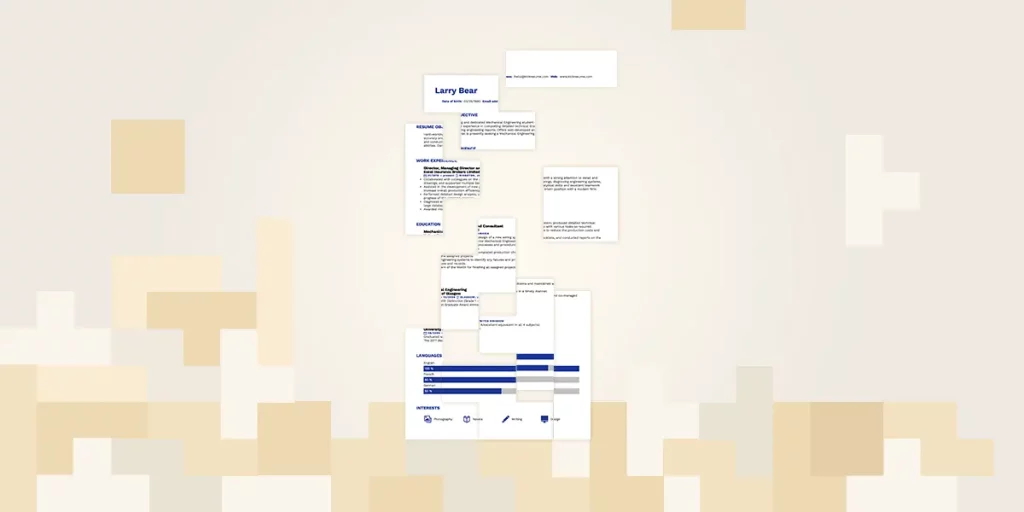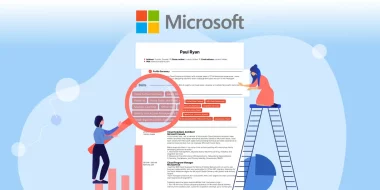Not sure which resume sections are necessary and which ones are optional? Struggling with how to organize the sections of your resume?
Sometimes you can feel like what you have isn't enough and then overcompensate by trying to include as many categories on your resume as possible. In these cases it's good to remember the golden rule — less is more.
Rather than trying too hard and ending up with a cluttered resume, you should stick to what is necessary. And add any optional sections which will complement it depending on your profession.
Illustrative examples of resume sections
Let's start with illustrative examples that show how sections should be ordered on a resume based on where you're in your career — whether you're a student/fresh graduate, an experienced professional or a career changer.
Experienced professional resume example
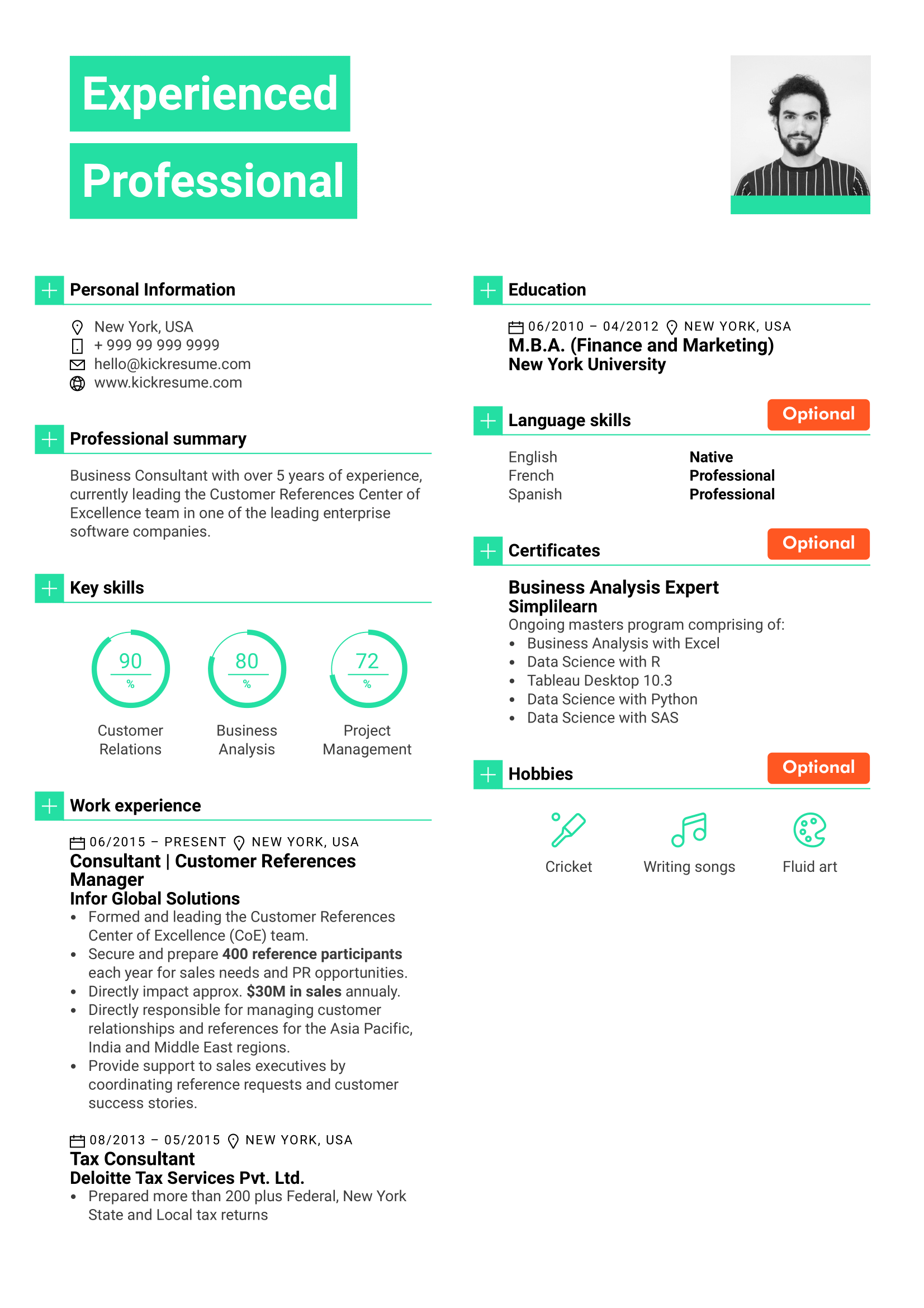
Student/fresh graduate resume example

Career changer resume example
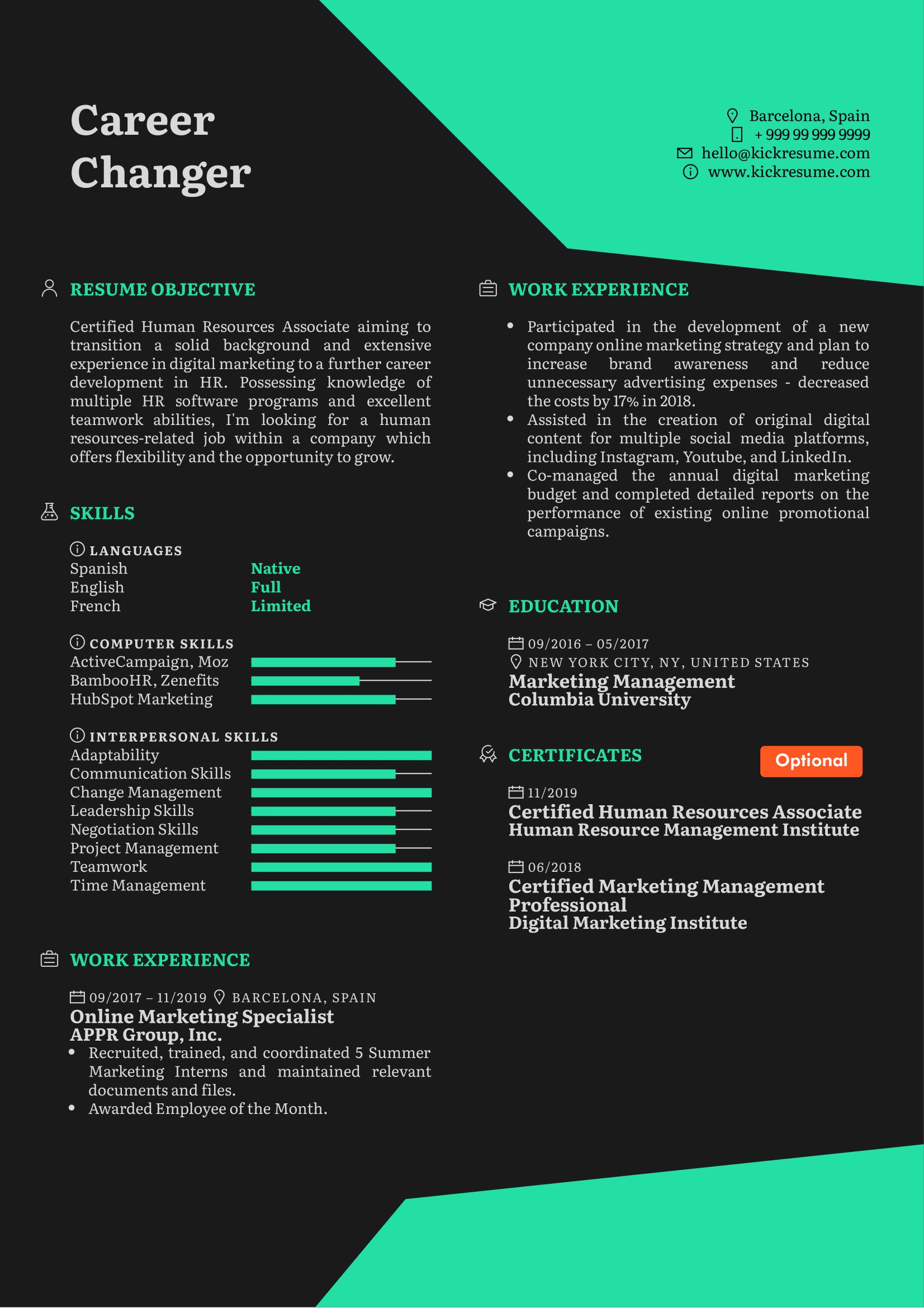
If you want to organize your resume in a seamless yet creative way, a quick and efficient solution is to use a customizable template. Just choose a suitable resume template for your profession and customize it to your needs.
Resume composition explained in 2 simple steps
So, how do you put together your own resume?
Follow this two simple rules:
- You need to include the required sections. Your resume won't be a resume without those.
- Other sections are optional and you can include those which are somehow relevant to your career or to the job you're applying to.
Which sections are a must and which aren't? Let's see!
Standard resume sections
Every resume should, definitely, include these five key sections:
- Personal information
- Resume summary or objective
- Work experience
- Education
- Skills
These are the most important parts of the CV for a recruiter. You shouldn’t leave any of them out. When you include these five sections, you'll have produced a standard resume with all of the necessary information.
Any additional sections, if added tastefully, are cherries on top.
Let’s have a look at each of these five individual sections to make sure you include everything you need to. There are also some different options for headings, some of which are more appropriate than others.
Tip: If you already have a great LinkedIn profile with all the information, there's no need to create a resume from scratch. You can simply convert your LinkedIn profile into a resume in one click.
1. Resume personal information section

What's the purpose of the personal information section on a resume?
You’ve probably guessed it. The purpose of the personal information section on your resume is to introduce yourself to the hiring manager. Therefore, it should be the very first section on your resume.
What should you include in personal information section?
- Name and surname
- Phone: If you're applying for a job in a different country, make sure you include the correct prefix code for your country. Be consistent with the format of the number in other documents.
- Email: Make sure to use a professional email rather than a goofy one back from when you were a teenager. Similarly, don't use your current work email. You will loose it soon anyway!
- Address: Usually recommended, but not necessary. Some employers send offers and rejections via post, or they may prefer local candidates living in a certain radius from the company. However, it can also lead to discrimination, especially when you decide to include your zip code — so, preferably include at least the state and city.
There's also optional personal information you can provide:
- Professional acronyms: Including any professional title abbreviations, education, certification — You earned them, go for it!
- Middle name: Optional. But make sure you're consistent in other documentation.
- LinkedIn and other social media: LinkedIn — Recommended if you have one. Other socials — Is it relevant for the job or industry? If yes, you can include it.
- Portfolio/Website: Again, include only if it's relevant for the job. In a creative industry it will definitely help!
Lastly, if you want to work with applicant tracking systems (ATS) and not against them, stick to a straight-forward heading, like "Personal Information" or "Contact Information". Stay away from headings like "Something about me".
Why is the personal information section necessary on a resume?
Naturally, by providing all the necessary information, recruiters will have no trouble getting in touch with you and invite you for an interview.
2. Resume summary or resume objective section

What’s the purpose of the resume summary or objective section on a resume?
The purpose of this section is to tell the hiring manager who you are and why you’re a great fit for the job or what your professional goals are (depending on whether you opt for summary or objective). Think of it as a teaser for the rest of your resume.
Should you use resume summary or objective?
- If you’re a student or recent graduate and have some experience, use a summary. In case you don't have any experience yet, use a resume objective to explain your future career goals.
- If you’re an experienced professional, use a resume summary to list your strongest skills and professional achievements.
- If you're a career changer, use a resume objective to communicate your motivations and emphasize your transferrable skills.
What should you include in resume summary or objective?
Resume summary:
- Write 3-4 lines (or bullet-points) of text summarizing how much experience you have, in what industries/markets.
- Highlight any specific skills or accomplishments you are particularly proud of.
- Tailor it to suit the job you want by adding keywords and related skills from the job listing — this will also give you a head start with ATS systems.
- Just FYI, a resume summary is sometimes also called a “professional summary” or a “resume statement”. Either is perfectly fine to use as a heading.
Resume objective:
- Highlight your motivation, future goals and any relevant transferrable skills.
- Make it short and sweet, ideally 2-3 sentences long.
- Connect your skills and abilities to the job you want.
- Use specific keywords from the job listing to help your resume get past the ATS.
Why is resume summary or objective necessary on a resume?
On average, hiring managers only give each resume 7.4 seconds of their time. Hence, why a good professional summary or objective is a must.You want to grab their attention from the get-go. Plus you’ll make their life a bit easier because you’ll immediately tell them who you are. As for the resume objective, it can also help you convince the hiring managers that you’re qualified for the job despite lacking industry-relevant experience.
If you’re still wondering how to write a professional summary and resume objective, make sure to check out our guide: How to Write a Professional Summary on a Resume?
3. Resume work experience section
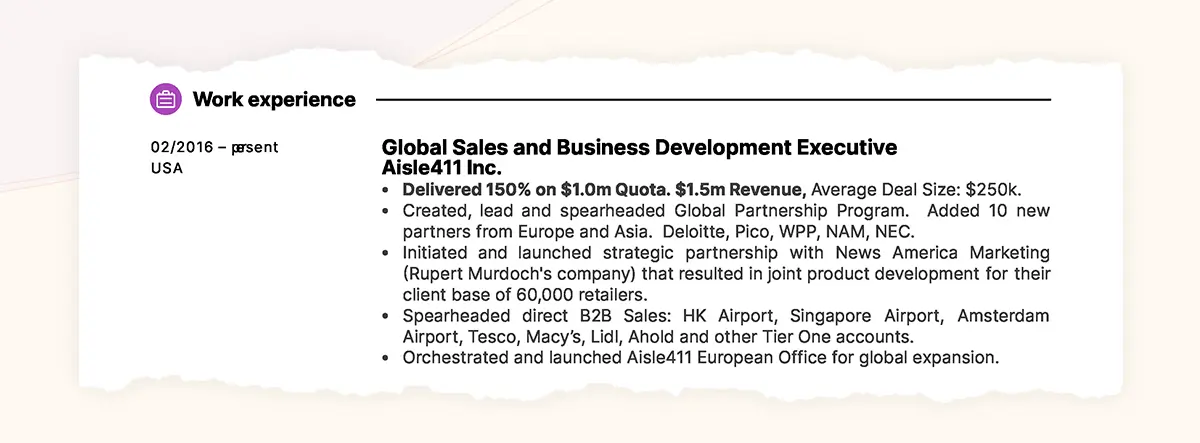
What’s the purpose of the work experience section on a resume?
The purpose of this section is to show that you’re a great fit for the job by providing a detailed summary of your past relevant work experience. It should give the hiring managers an overview of what jobs and job titles you’ve held in the past and should demonstrate your professional growth.
What should you include in the work experience section?
List this section inreversed chronological orderby starting with the most recent work experiences. Include:
- the name of the company you worked for;
- where it is located;
- your job title;
- and for how long you’ve worked there.
Then you want to include:
- 3-5 bullet points highlighting your past achievements for each entry. Don’t use this space for simply listing the job description and your responsibilities. It will then seem like you did the bare minimum. Focus on the positive results instead.
- If you lack relevant achievements, show your problem-solving skills. Explain how you’ve solved a specific problem in the past.
- Tailor it according to the employer’s needs and priorities. Do this by searching for any recurring keywords, skills or experience mentioned in the job listing and then explain how you’ve demonstrated that skill in your previous jobs.
- Quantify your results. For example, instead of saying you “increased daily website visitors” rather say “increased the website’s daily visitors by 30%”.
- Use professional headings for this section. By doing this, you’ll avoid being excluded straight away by ATS systems. Quirky headings probably won't be recognized by ATS. Simply name it “Work Experience”.
If you're not sure how many jobs to include, check out our article How Far Back Should a Resume Go?
And in case you’re a student or recent graduate, use this section to mention any relevant part-time jobs, summer jobs, volunteer work or internships you’ve had (following the same tips above).
Why is the work experience section necessary on a resume?
Your work history section is the most important part of your resume. When you think of a resume, the work experience section is probably the first thing that comes to your mind. And you’re not alone. Based on this section employers determine whether or not you have what it takes for the job.
For more, have a look at our guide: How to Describe Your Work Experience on a Resume?
4. Resume education section
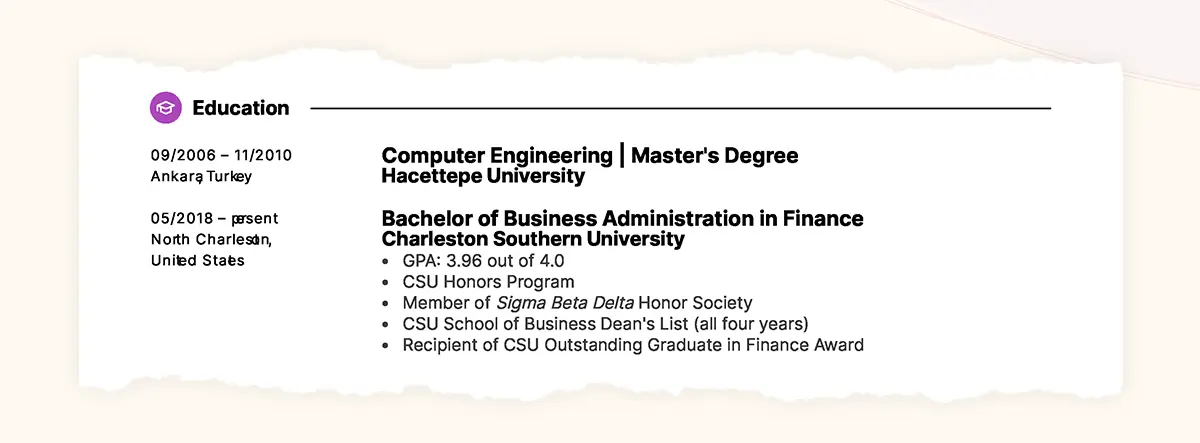
What’s the purpose of the education section on a resume?
The purpose of this section is to show employers what your educational background is. By including all of your degrees and relevant academic accomplishments in the education section, you can impress your employer and show you have the necessary background. Moreover, if you have a degree from a prestigious university, it can give you an advantage over other potential candidates.
What should you include in the education section?
If you’re an experienced professional, it’s enough for you to mention your highest degree. Only include 3 things:
- name and location of your university;
- name of your degree or field of study;
- year when you started and graduated.
If you’re a recent graduate, education section is the core part of the resume. Hence why you should make sure to make this part a little longer by adding extra details to make it prominent. Extra information to add to the education section are:
- Relevant coursework
- GPA (if higher than 3.5)
- Awards (Dean’s list, magna cum laude, subject-based awards)
- Scholarships
- Relevant student societies (especially if you were in the committee and played an active role)
- Academic publications
- Studying abroad
- Internships
- Thesis name and description
Why is the education section necessary on a resume?
Employers are naturally interested in your educational background. Some top companies even have specific degree requirements for their applicants. You should always include education on your resume, no matter where you’re in your career. However, as you become more experienced, you should keep it only brief.
For example, after you’ve gained 5-10 years of practical experience as a teacher, you can simply state that you have an MA in education as your work experience is now more important.
But if you’ve recently graduated, it’s naturally the most important part of your resume.
Check out our comprehensive guide: How to Put Your Education on a Resume?
5. Resume skills section
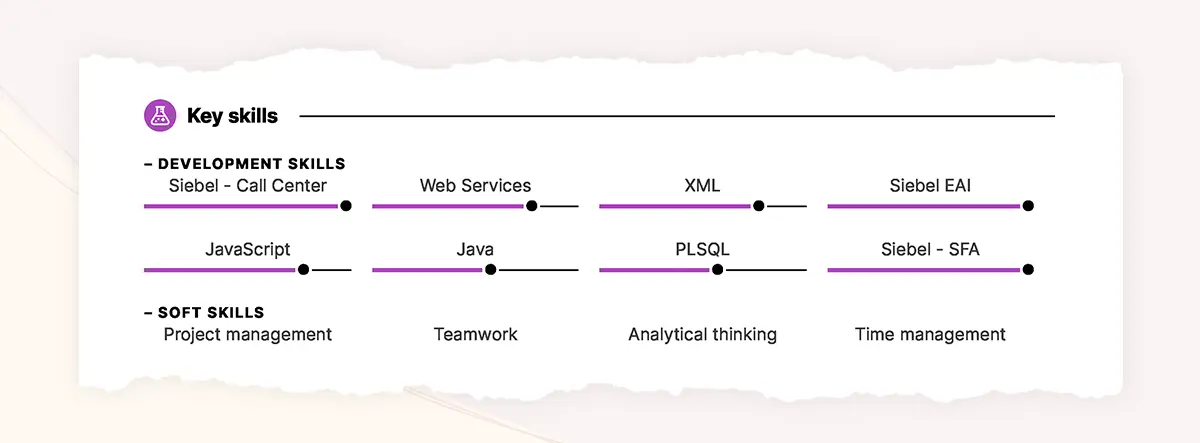
What’s the purpose of the skills section on a resume?
The skills section of your resume shows employers you have the skills and abilities required for the role. In fact, a well-written skills section can help convince hiring managers to interview you. However, remember that you should demonstrate these skills in the work experience section as well.
What should you include in the skills section?
Just follow these simple rules:
- Write a list of your key skills.
- Check the description of the job you want and match your skills.
- Create a skills section and consider dividing up the section to hard & soft skills subsections:
- Hard skills are technical abilities you were taught. For example, programming languages or WordPress.
- Soft skills have to do with your personality. For example, collaboration, time-management, or dependability.
- Alternatively, pick relevant skills and divide them into several subsections like computer skills, marketing skills, languages, and others.
Remember, don’t list skills that you don’t have, that aren’t relevant for the job, and skills that everybody should have.
Why is the skills section necessary on a resume?
By listing your key skills, the hiring managers will see straight away that you’re a potential fit, whether they’re looking at your resume via an ATS or manually. It also makes it much easier to tailor your resume to specific jobs. Moreover, having a separate skills section is a quick and easy way to list keywords on your resume. This can give you a head start with ATS systems, since they search for specific keywords.
Check out our comprehensive guide on how to write a skills section for your resume?

Optional resume sections
Apart from the standard five resume sections mentioned before, there are other resume sections which are optional. It's important to note that each of these optional sections could be incorporated in one of the standard sections.
This is why you should only include an extra section if you feel like you have enough to offer in that particular category. For example, if you speak one language well and only know the basics of a second one, then don’t include an extra languages section.
With that being said, adding one or two optional sections to emphasize your qualification for the job can be the icing on a cake. For example, if you work in academia, adding an extra section dedicated to your publications or references is going to catch the eye of a recruiter in an instant!
So, which optional resume sections are we talking about?
- Achievements and awards
- Certifications and licences
- Language skills
- Publications
- References
- Hobbies
- Social media
- Volunteering
- Custom sections
Let's talk about each one in more details.
Achievements and awards section
If you feel like you have enough content for this section then it will definitely help you stand out. But bear in mind – your achievements should be scattered through your entire resume, especially in the professional summary and work experience section.
If you decide to dedicate an entire section to your awards and achievements, make sure you prioritize the ones relevant to the job. Also, pick the most noteworthy ones.
Here’s what kind of accomplishments you can include:
- Awards for specific academic activities or subjects (e.g. Prize for Excellence in Level 2000 Chemistry)
- Awards from professional associations (e.g. CSS Design Award)
- Awards like Salesperson of the Year, Employee of the Year, or Best Performer
For more, check out our comprehensive guide: Awards and Achievements on a Resume
Certifications and licenses
A certification is basically a proof that you have specific expertise and skills.
Is it a good idea to include a specific section for certifications on your resume? If you have various certifications that are important and relevant for the desired job – Yes! It shows your willingness to learn and the desire for personal growth.
Here’s how to include certificates on your resume:
- List your certificates in reverse chronological order, beginning with the most recent one.
- Include the name of each certification, authority, its URL or code, and any relevant dates.
- Add the location in case your certificate is state specific.
- Describe each certificate in more detail. Explain what it entails.
Languages
You can either include languages as a subsection in hard skills, or you can create a separate resume section only for languages.
Only do the latter if speaking a specific language is a key part of the job, or if speaking many different languages will help you get the job.
List the languages using a single language proficiency scale. Rather than using charts to describe your proficiency level, use words – charts may not register on ATS.
For more detail, check out this article: How to List Language Skills on Resume (w/ Proficiency Levels & Examples)
Publications
If you work in academia or in a science field, having your research published is a great achievement. If you have multiple publications it may be a good idea to have a separate section for them in your resume.
The important thing here is to correctly format the information about the publication – i.e. make sure to correctly use the common citations styles (Harvard, APA, MLA, etc.). Choose one depending on the author’s preference or according to the discipline (e.g. APA style is commonly used in Psychology field).
References
Including references on your resume is not a common practice anymore. However, in some situations it is acceptable to include references. This is when:
- Your reference is someone well-known in the field;
- You’re a fresh graduate;
- The job listing specifically asks you to include references on your resume.
Hobbies
People tend to view the hobbies section as a redundant "filler". While this may be true in some cases, it can also be quite useful. Here’s why:
Many companies nowadays look for candidates who will not only be good at their job, but they’ll also be a good fit for the company culture. It shows you as a real person rather than just an employee. Moreover, it's a good conversation starter for your job interview.
So, if you do decide to add the hobbies section, make sure to be really specific. For example, rather than "Reading", say "Historical fiction novel lover".
Check out this guide to find out more about how to list hobbies on a resume.
Social media
Hiring managers will google you at one point or another. Be one step ahead and use it to your advantage. Include the social media you want them to see. Creating a separate social media section can be a great way to do that.
Including LinkedIn is always a good idea, since it can serve as an extension to your resume. Make sure to also include any online portfolios, personal websites, or even your Instagram if you work in a creative field.
Remember, your social media can also prevent you from getting a job. So ensure that your social media presence is polished and sophisticated.
If you decide to only include 1-2 social media profiles, you can fit it in your personal information section.
Find out more about how to include social media on a resume.
Volunteering
Adding a volunteering section on a resume can really help you stand out. It shows your skills, your motivation and that you take initiative. And hiring managers love that. It's also helpful to include a volunteering section if you have limited professional work experience.
This also means that if you have plenty to offer in the work experience section, don’t include volunteering at the expense of leaving out important content.
Include:
- Name of the organisation;
- Duration;
- Your job title/position;
- Explain what you did and what you achieved.
For more information, check out this article: How to Include Volunteer Experience on a Resume.
Custom sections
You can add a custom section to you resume if you'd like to emphasize any accomplishments which wouldn’t fit to any of the conventional categories usually found on a CV.
For example, if you’re a programmer you can create a "Custom projects" section in which you detail your work. If you’re a copywriter or a journalist, you can make a "Media I wrote for" section. If you’re a scientist, create a "Laboratory skills" section on your resume.
Almost every industry has a potential for a custom section that is distinctive to that discipline.

How to organize your resume sections?
The final step in creating a perfect resume is to organize your sections in the right way.
The Personal information section and resume summary or objective should always come first. However, depending on where you are in your career, you may want to organize your resume differently.
Here’s an ideal resume composition suggested by our in-house HR expert for various career situations:
Order for students or fresh graduates:
- Personal information
- Resume summary/objective
- Education
- Work experience
- Skills
- Volunteering and other optional sections
Order for experienced professionals:
- Personal information
- Resume summary
- Key professional skills
- Work experience
- Education
- Certifications, technical skills, and other optional sections
Order for career changers:
- Personal information
- Resume summary/objective
- Skills
- Work experience
- Education
- Other optional sections
Up to speed with organizing your resume sections effectively? Nice work! Now, enhance your understanding further with our incredible selection of resume samples. They're designed to provide inspiration and insights into crafting a top-tier, organized resume.
